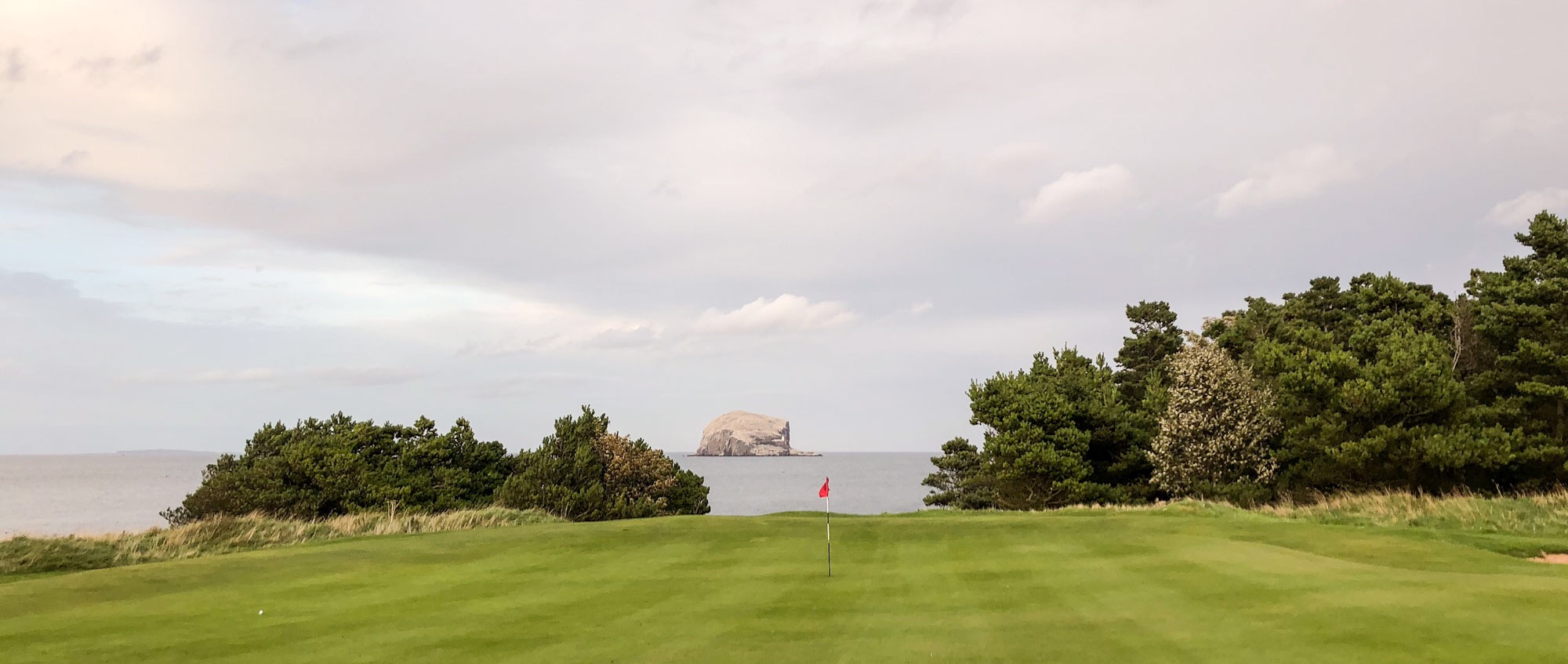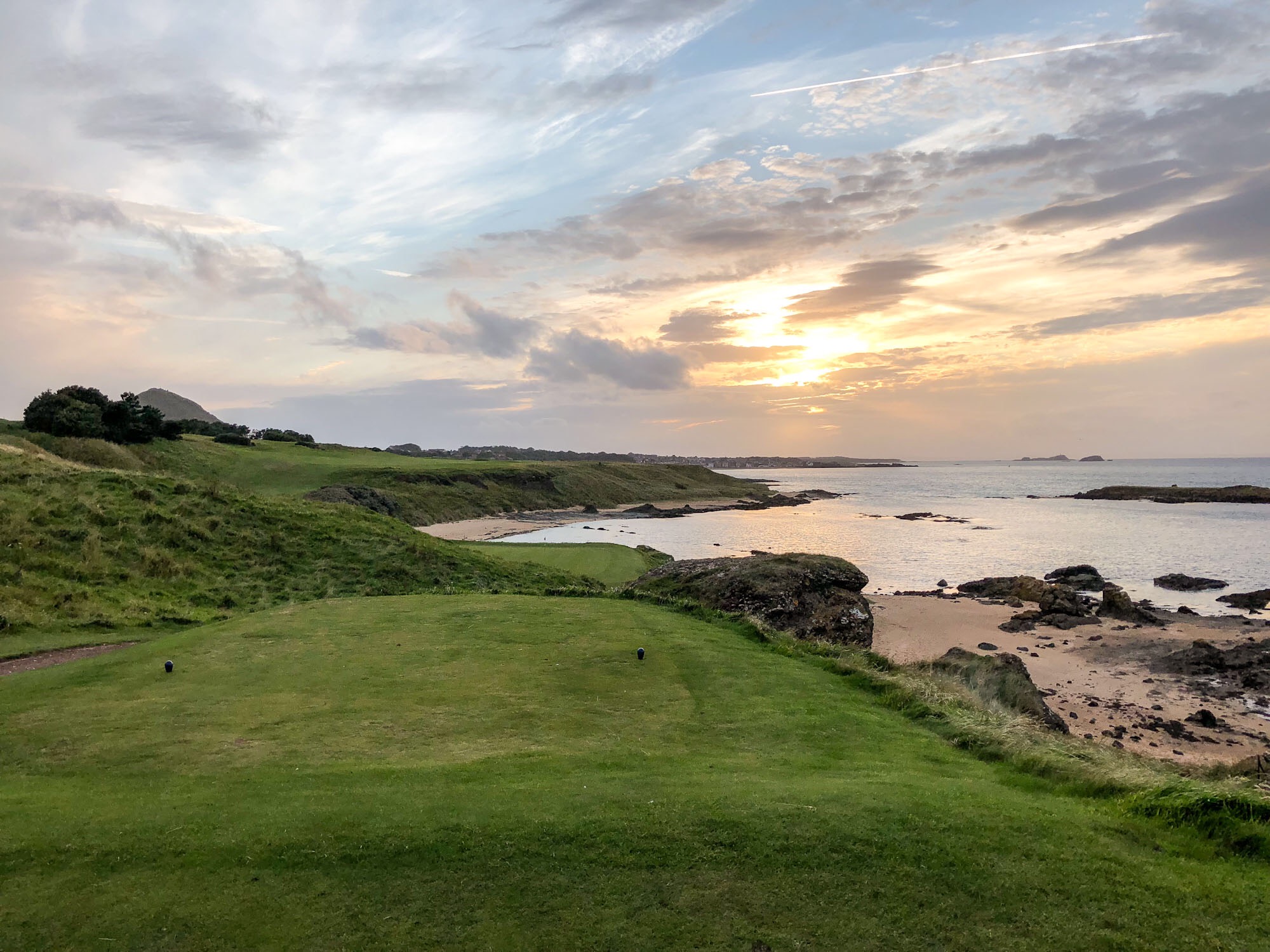The trip to North Berwick was a relaxed tour, but the rain, the kilt carriers and the Scottish Senior Open cost more time than I thought, so I had less sunlight than I had hoped for the planned lap on the eastern course of North Berwick.
I already knew that the campsite had direct access to The Glen, the second golf course of the town. Therefore I did not give up the plan to play this course in the afternoon of my arrival, even though it was already five o'clock when I pitched the tent. I hurried because I had set myself a task for today's round of golf. I have played so poorly in recent weeks, not paying much attention to the game. That was perfectly all right, because simply something else came to the front: cycling, writing, my own thoughts. That's exactly how the journey was designed from the very beginning. But golf has not only been an important part of my life in the last decade, it is also a defining part of this journey.
If I play a round of golf and play relatively bad results, then I can live with that very well. What always upsets me, however, and thus initiates a vicious circle, a process that continues to intensify, is if I don't get completely involved in the moment of the stroke and in the seconds before it. This is particularly good for me to observe while putting. With this stroke the technique is relatively easy to understand, the movement is simple in comparison to other shots. Therefore the attitude towards the stroke is even more decisive than with other strokes. Especially since the putt has a final meaning: If the ball falls into the hole or stays close to the hole, then the result is certain, while all other strokes - at least usually - still cause following actions, which bring along their own dramaturgy and demand. On days or weeks when I play golf at my personal best, I'm almost completely focused on every single putt and can see the balls fall into the hole before I even reach for the club. This ensures a confident and consistent movement, the results are then only a logical consequence, because what actually applies to all golf strokes is most reliably observed during putting: Attempting to slow down the club head during movement regularly leads to irregularities, but above all only by chance to the desired result.
What was I going to say? Uh, yes: In the last few weeks I haven't done exactly that, namely to get completely involved with every single putt. I played too often because it was part of the journey and not because I wanted to play. That doesn't sound like a very hard fate, right? I agree with that. But the question behind it is: What do you do, what else do I do, just because I think I have to do it? And what does it lead to if you, if I, just do it again and again, without regularly questioning it? I have been asking myself this question for a long time and normally put it on the pile of questions dealing with the topic of complexity reduction. To do something simple often means to do something in a simple way. But having to do something simply, on the other hand, is also the lack of personal freedom. Who decides what to do? And who decides for you, for me? But first of all enough of an excursion into the hidden world of golf and every other thing that one pursues with passion and seriousness, because everywhere there are hidden learning fields and analogies.
The task I set myself for today was actually quite easy to solve: A concentrated round over the whole distance of 18 holes. I had set myself a clear goal, which I could reach under normal circumstances. If I were to reach or even undercut this goal, then tomorrow I would tee off on the West Links, the undisputed top dog of the town, otherwise I would skip it.
I still had a little over 2.5 hours to play my round on the almost deserted course. The course is full of beautiful views of the North Sea, the steep coast and Bass Rock, which characterizes the place in a special way. This volcanic island is a paradise for bass gannets and is home to the largest colony of the bird's northern species. Around 150,000 animals live on this gigantic chunk of volcanic rock, which is over 100 metres high and rises out of the water like a baseball cap. With little imagination, the lighthouse even looks like the swoosh of a certain sports equipment manufacturer.

A little useless knowledge that Mr. Wiki just brought to my attention: Robert Louis Stevenson's cousin built the lighthouse here, which doesn't impress the Stevenson expert at all and only makes him shrug his shoulders. As everyone knows, the Stevensons were a lighthouse dynasty. Given the importance of phallic buildings in the life of their creator, it's hardly surprising that Dr. Jekyll had minor problems, isn't it?
It's nice here, you can get lost in your thoughts, I apologize for my excursions. Back to golf!
My task was already endangered on the first hole. On the one hand this is relatively unpretentious and on the other hand quite interesting due to a dominant element which shares it in the opposite way with the 18th hole. After about 230 meters it goes up steeply about 20 meters, because the majority of the course and also the green of the 1st lies on a high plateau. Some players I know would now argue that they would not be able to fully commit to their 9 iron from the tee box, otherwise they would lay in the ascent. For me it was a good straight drive, and then, for lack of an alternative in my narrow set of only seven clubs, a 7 iron to the flag. I topped it miserably into the slope and from there it struck again, the socket. I was about to eat my wedge, but I thought about digestive problems again and practiced in serenity. I started with a triple-bogey and was of course in the best of spirits and was all the more looking forward to the task. Well, that's how it was anyway. Fortunately, things got better from then on and I don't bother you with the game any longer. The bottom line was that I stayed three strokes below the target and came back to my vehicle with sufficient lighting.

The hunger forced me into the village and I found a quite decent Italian who was definitely ready to prepare carbonara without cream. Here, of course, the question arises to one of the best hosts in Europe, who today attracted attention by surprisingly defending the high-percentage milk product in the commentary area: Do you prepare carbonara beautiful with boiled ham and cream recently? And afterwards a cappuccino with a dash of whipped cream? :-D
By the way: Jan Boehmermann told Oli Schulz recently in an edition of the amusing podcast that Carbonara is not an original Italian traditional recipe, but goes back to American soldiers in World War II. Boehmermann and his team would be quite capable of infiltrating the Internet with such an idea in order to prove the origin of fake news, because there are actually several sources supporting the thesis. So should one of the next episodes of neo magazine reveal that they did: I knew it, didn't I? If that doesn't happen, then we won't talk about it anymore.
As a small reminiscence of the Scottish surroundings, the restaurant fried the salad Caprese in beer dough for starters. Surprising, isn't it?



